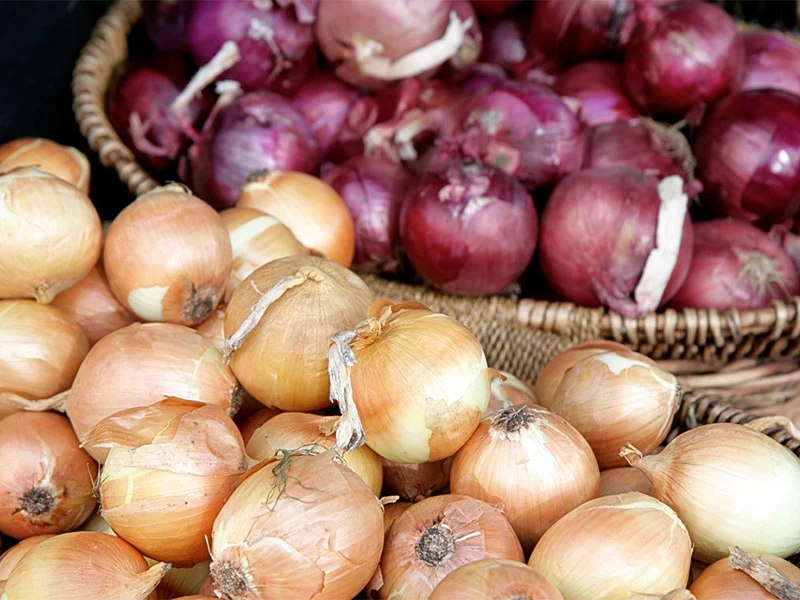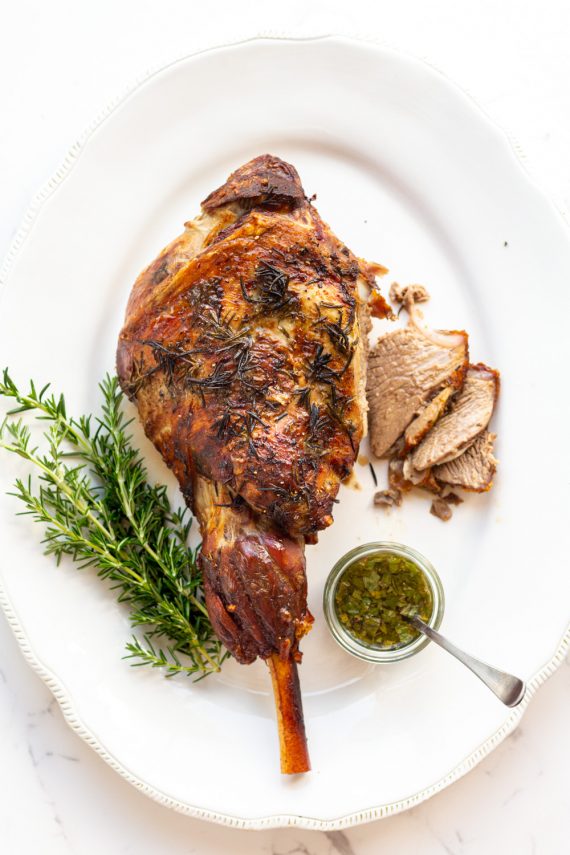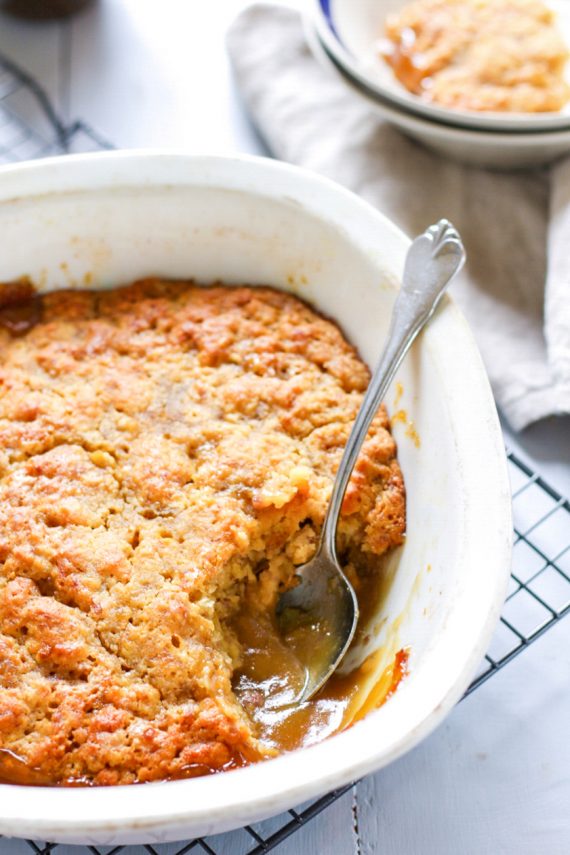Sometimes it feels like you can’t pick up a single seasoning mix, pre-package meal, or choose a meal in a restaurant without it containing a sneaky little FODMAP called onion. Onion (even in the smallest amount) can cause severe tummy troubles! When transitioning onto the low FODMAP diet it can feel a bit daunting figuring out how to recapture flavour in your meals, without using onion as a base flavour. Let’s figure out how to replace onion on the low FODMAP diet and learn why onion is high FODMAP.
Why is onion a problem on the low FODMAP diet?
Onion contains fructo-oligosaccharides, which are commonly referred to as fructans (1 2). Fructans are short chain carbohydrates and are found in foods like onions, garlic, wheat, rye, barley, and artichokes (1 3). Humans do not have enzymes to break down either of the oligosaccharide sugar groups, which means they are malabsorbed in the small intestine, and then fermented by the gut bacteria, leading to irritable bowel syndrome (IBS) symptoms in susceptible individuals (1 3). This is why eating onion can cause very unpleasant IBS symptoms. During the FODMAP elimination phase it is recommended that you remove all onion (fresh, minced and dried) from your diet (2). This means you need to check all packaged goods, sauces, and any dried spice mixes like curry powder, five spice, chilli powder for added onion, as even a little bit might be too much! You can then test fructans/onion in the reintroduction phase, to see if you can add small amounts back in.
How do you replace the onion flavour while eating low FODMAP?
There are several ways you can replace the onion flavour while eating low FODMAP:
- Use the green tips of spring onion or leek (3). The white spring onion bulbs and leek bulbs both contain fructans just like in onion (3). This means you can only use the dark green tips of the spring onions and leeks, and you need to stop cutting when the colour starts transitioning to lighter green. I often fry the green tips (just as you would onion) before adding other spices and herbs to the dish.
- Chives are low FODMAP onion alternative and provide dishes with a mild onion taste with just a hint of garlic flavour (3). You can buy chives at the supermarket in dried or fresh forms.
- Onion infused oil is a tasty and safe replacement for onion in low FODMAP meals. The fructans present in onion are only water-soluble and not oil soluble (2 4). This means the onion flavour transfers into the oil while the fructans stay trapped in the onion pieces, as there is no water in the oil for them to leech into (4). You can sometimes buy onion infused oil in your local supermarket. Otherwise you can sauté onions in olive oil to infuse the favour, then remove the onions (make sure you remove all the onion fragments), and use the flavoured oil immediately in the dish you are preparing. You cannot sauté the onions in the oil if you have already added other ingredients to the pan, as the fructans will leech out of the onion and into those other ingredients.
- Asafoetida powder is another low FODMAP onion alternative recommended by Monash University (3). Dried asafoetida or ‘Hing’ comes from the taproot sap of the Asafoetida plant (a relative of the carrot family) (5). This spice contains a range of potent sulfur-based flavor and aroma compounds that taste a lot like onion once cooked (5). However, these sulfur compounds give the spice a very pungent odour, which means the spice is sometimes referred to as ‘devil’s dung’ (5). Asafoetida powder is a spice commonly used in Indian cooking and you only need a tiny pinch of it to flavour your meal (5). If you are highly sensitive to gluten then make sure you buy a gluten free/wheat free asafoetida powder. The amount of asafoetida powder commonly used in cooking is generally considered safe (6). However, if you have other medical conditions or are pregnant, breastfeeding or cooking for an infant please consult your doctor before using the spice (6). It is also important to note that asafoetida powder can also interact with other medications, so check with your pharmacist or doctor before using (6).
Are you ready to take control of your gut symptoms?
No thanks, my gut is perfect.
Article continues below
How do you use asafoetida powder?
Using asafoetida powder is actually very simple, once you get over its pungent smell. Simply add a small pinch of the asafoetida powder (Hing powder) to your oil or hot fat and fry for 15 to 20 seconds before adding the other spices (5). This will allow the flavour to infuse into the oil and it will also decrease the pungent odour, making it more mellow and appetising (5). Then you can add the rest of your ingredients and continue cooking according to the recipe.
Why can’t you just take out the onion before you eat the meal?
Unfortunately, when you cook with onion, the fructans can leech from the onion into other parts of meal, as they will dissolve in any water that is present in the other ingredients you are cooking. While not eating the onion pieces will reduce your overall FODMAP load, it may not reduce it enough, as the fructans will have become infused in other parts of the meal. Therefore, in the elimination phase, you need to either avoid onion or use safe onion substitutes. After the reintroduction period, you might find you can tolerate leaving the onion pieces in whole and then remove them before eating, but you need to test fructans in the reintroduction phase first.
Final Thoughts
So remember to avoid onion at all costs during the elimination phase, and make sure it doesn’t sneak into any of your processed food! Have fun replacing onion with safe alternatives like the green tips from spring onions and leeks, onion infused oil, or a pinch of asafoetida powder. Happy cooking everyone!












Thank you SO MUCH for explaining the science behind this. Have been looking for an onion flavor substitute and appreciate knowing that chives are low FODMAP, and how the fructans leech into water!
You are welcome! I hope you can now replace onion and garlic flavours with confidence.
The best help ever! As a vegetarian (with an extremely adventurous palette) recently diagnosed with IBS, the sense of “daunting” when considering precluding onion family flavourings is an understatement!! “Terror” would come closer. Your info saves the day with the reassuring revelation of being able to to substitute chives as well as onion and garlic oil. Possible word of warning though – if true, maybe good to include in your on-site info – I’ve just read some supplementary information on another site which cautions that garlic oil when home-made, should be used immediately as it can develop serious food pathogens if left – even refrigerated – for longer than a day or two.
I’m so grateful to you for the above – thank you!
Hi Ruth,
Thanks for commenting! Onion is used as a flavour base in so many recipes so I completely get that it can be challenging having to preclude it. Hopefully, our suggestions can help. We do talk about garlic infused oil in this article: https://alittlebityummy.com/garlic-and-the-low-fodmap-diet/
We do have a warning note on how to use homemade garlic infused oil to reduce botulism risk. Thanks for taking the time to make sure we had that safety information though!
I have tried all of the suggestions but my meals are still lacking flavour. I tried a chicken stock that helped but it had traces of onion too. Anything else I can try? 🤔
Hi Sarah,
These tips definitely work but you still need to have a balance of other flavours in the meal to make something truly tasty. Do you want to email me a couple of the meal ideas/recipes you are trying to replace onion in so I can take a look? Then I can help you with some more suggestions.
Adding stock is a good idea – have a look in the Monash University Low FODMAP app for some low FODMAP stock options. I look forward to hearing from you soon!
Great advice. We use chives in dishes like frittata and grow them in our own garden – easy to grow in a bed or a pot and so fresh!
Liking the advice about asafoetida. Boy is this an acquired taste, sharing a language root with ‘fetid’ or unpleasant smelling. I love the smell and taste of it now but had to start with just a small pinch, as Alana recommends – the bottom of the back of a teaspoon to start with. It’s a great spice and potentially anti-inflammatory, when used in small doses. Be sure to store it carefully, though, or the scent will take over your whole spice cupboard! We have ours in its original pot, double-wrapped in 2 food bags, in a sealed glass jar!
I recently read that Monash tested pickled onion and found it was low fructans (!). I can’t find any recipes online for making my own that would quality as low fructans, maybe it’s too good to be true? Any advice would be appreciated as I know I am sensitive to both onion and garlic. thanks! 😉
Hi Molly,
We would recommend buying large pickled onions from the supermarket instead. These will have been left in the pickling brine for a longer length of time which will allow more of the fructans to leach from the onions and might help reduce the FODMAP content further. Does that help?
Hello
When making congee may I put spring onion in to flavour the broth then strain the onion out so the flavour is infused in the water ?
Hi Lizi,
Thanks for commenting. We’d suggest you only use the green spring onion leaves in the dish and avoid using the spring onion bulb and stem. The bulb and stem contain fructans which will leach into the liquid content of the dish and potentially make it higher in FODMAPs. We hope that helps.
Hi, just wanted to say: “FreeFod” has a powder replacer for onion and garlic powders. It works great! and smells and tastes like the real thing! & they’re certified by “FodMap Friendly”! I use them in about everything. You can order through Amazon or their website. (Just a note, no I don’t work for them, lol, just a big fan!)
It’s great to hear you’ve found a low FODMAP certified replacement that you are enjoying!